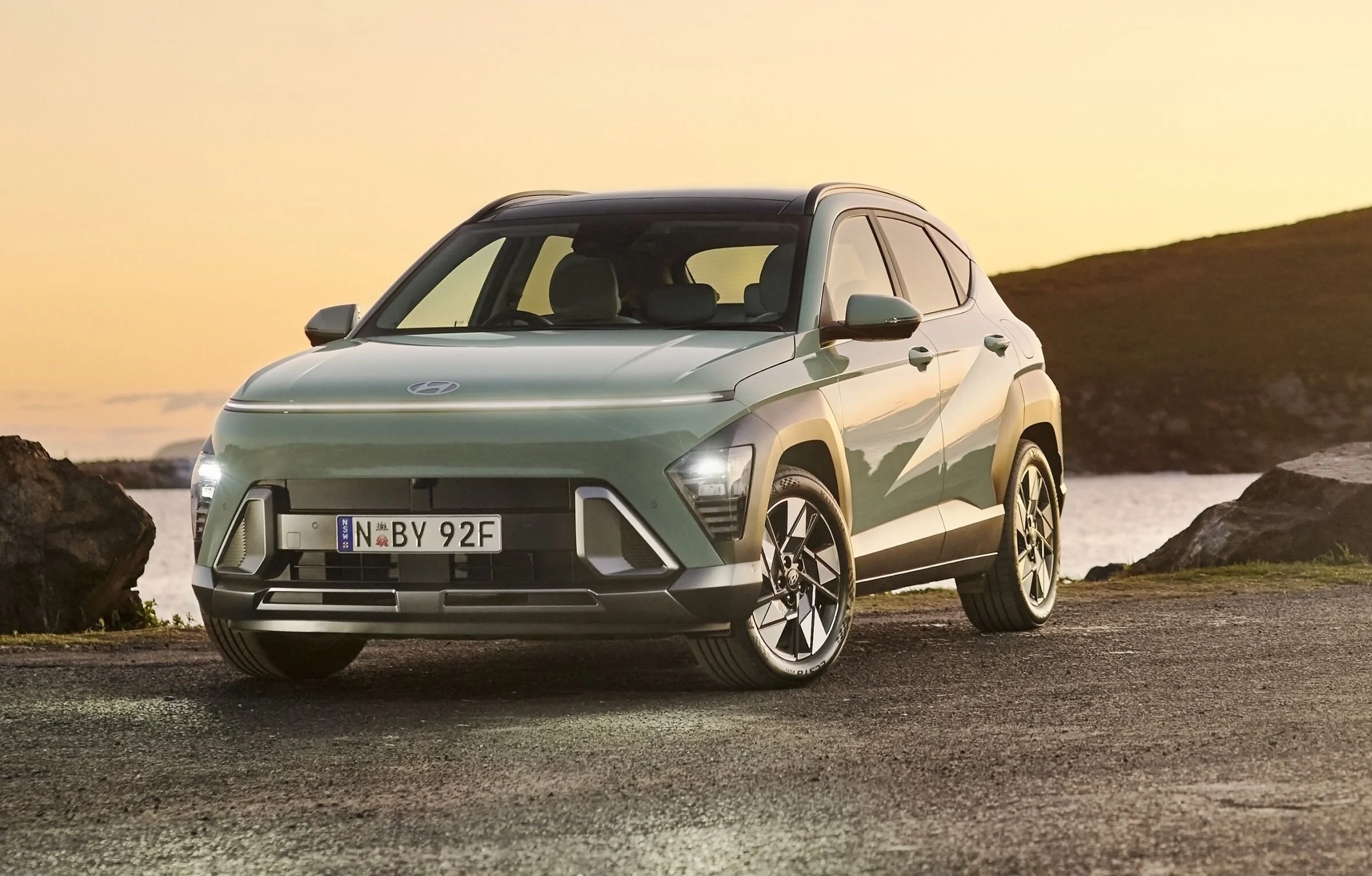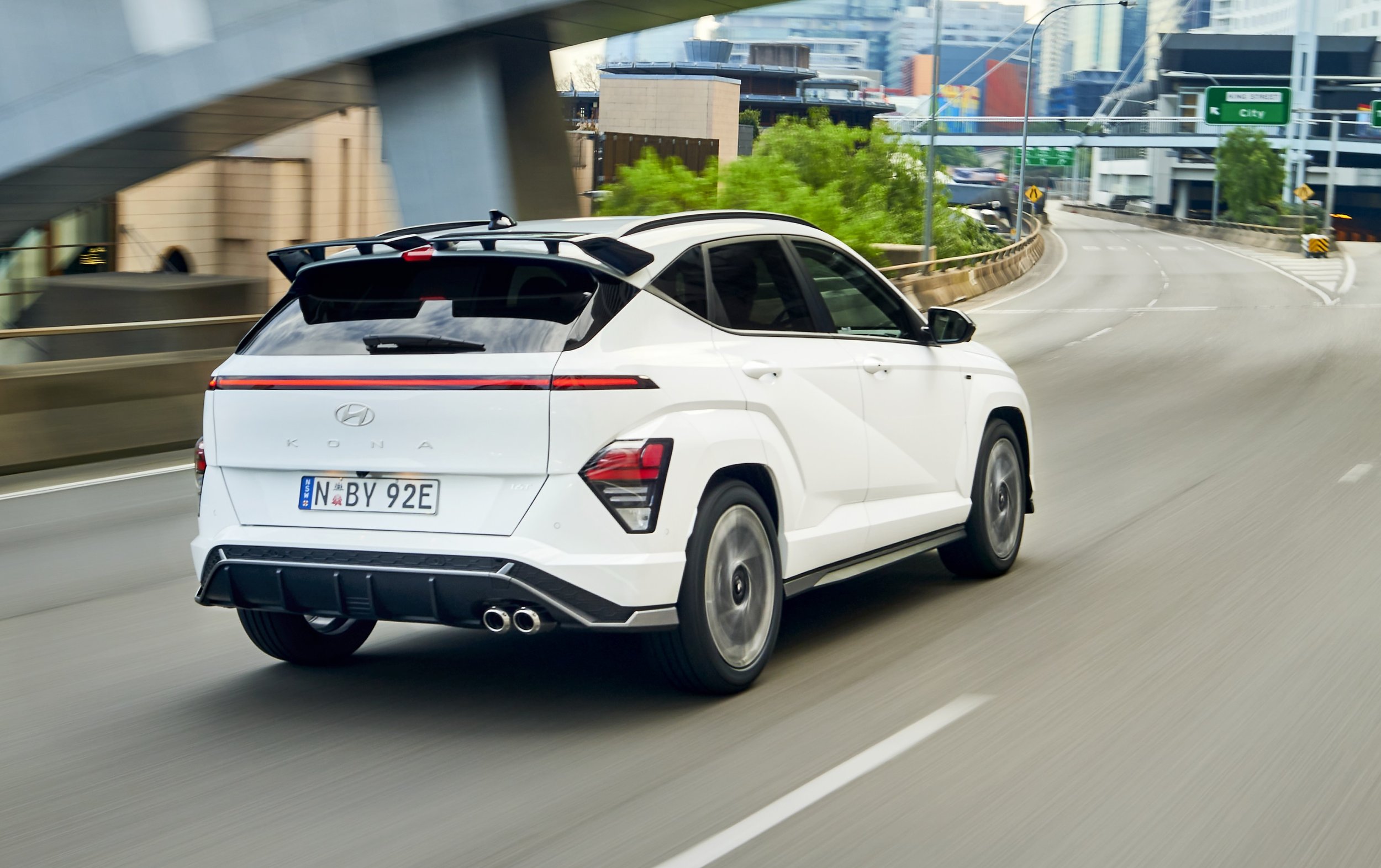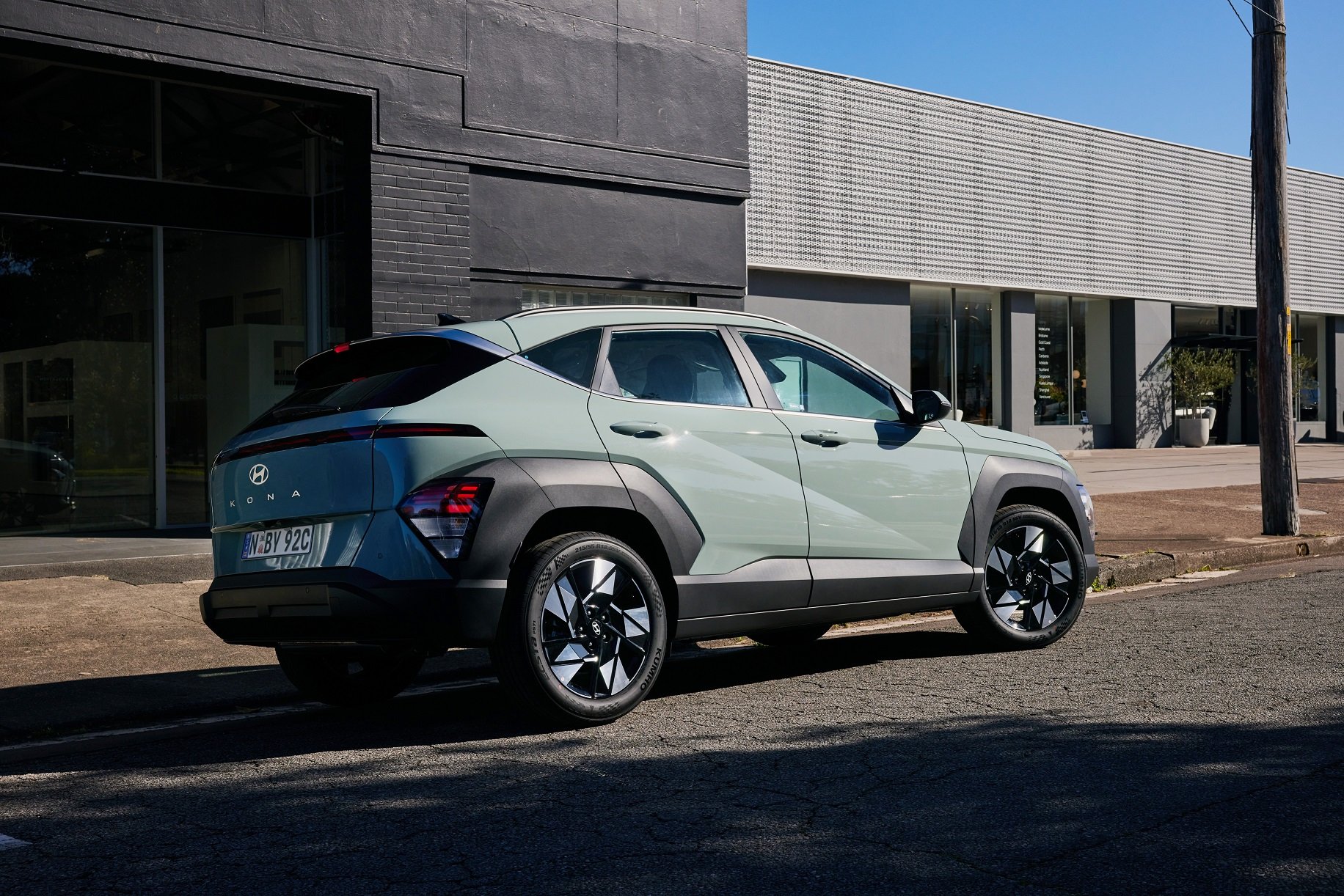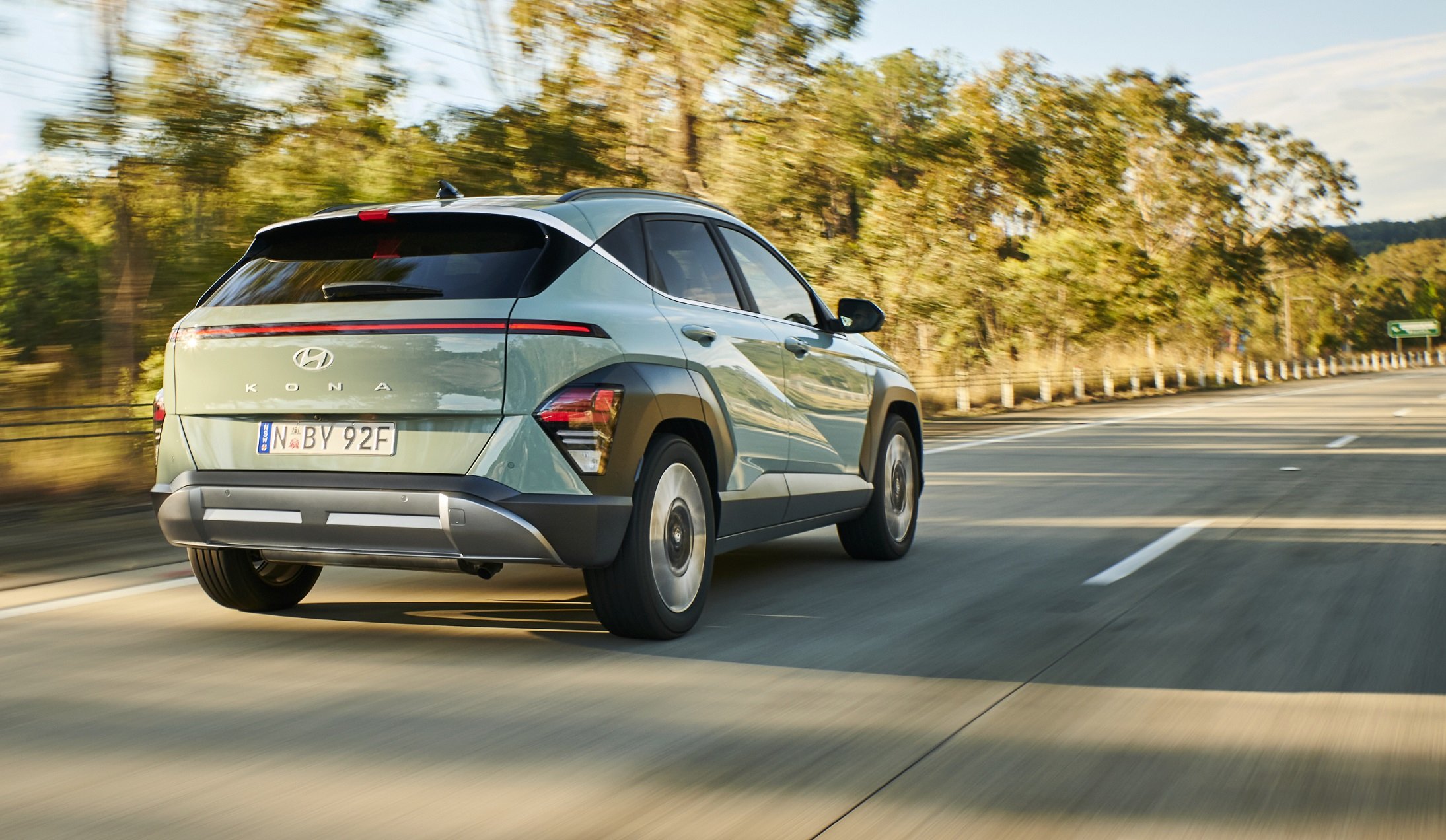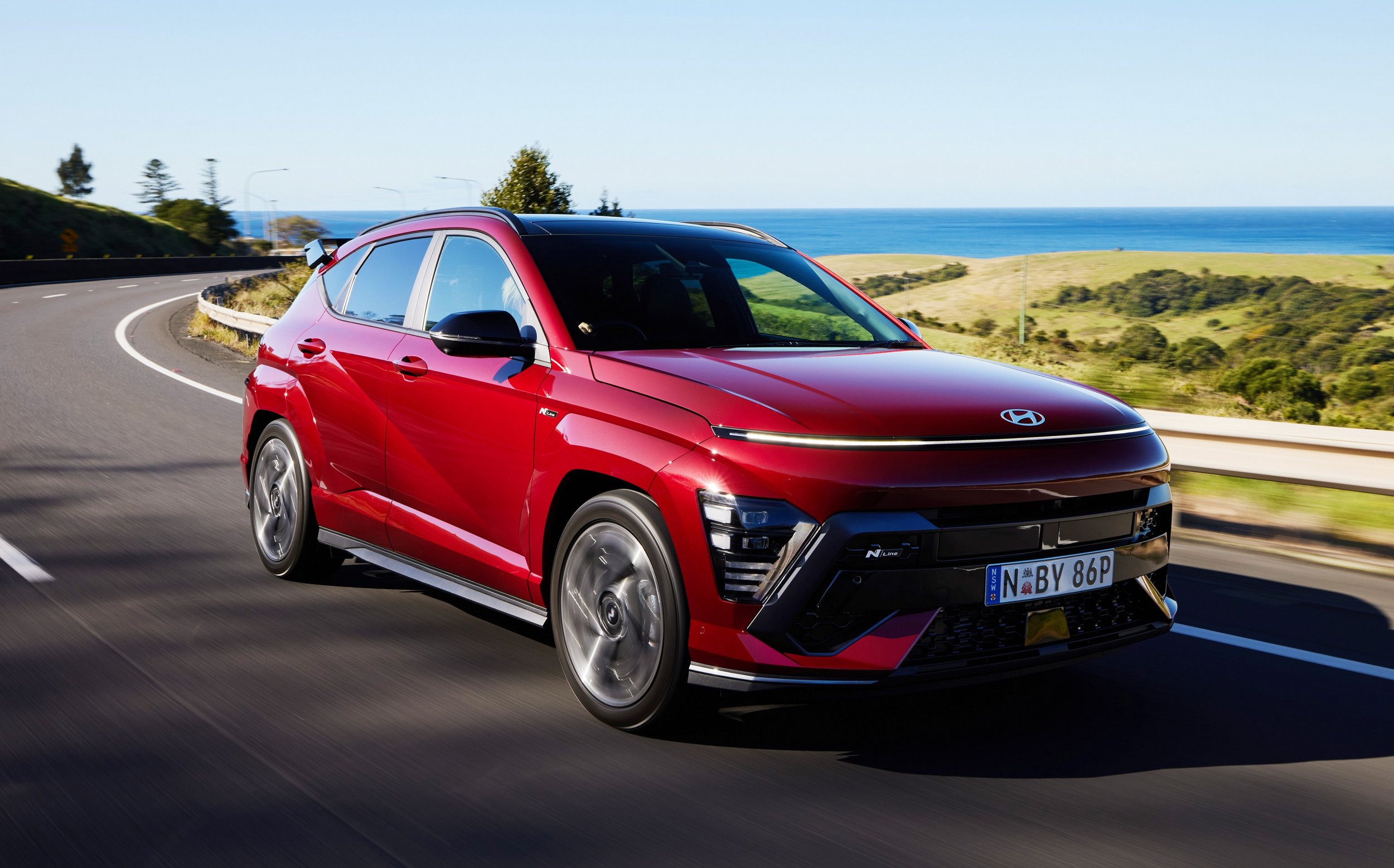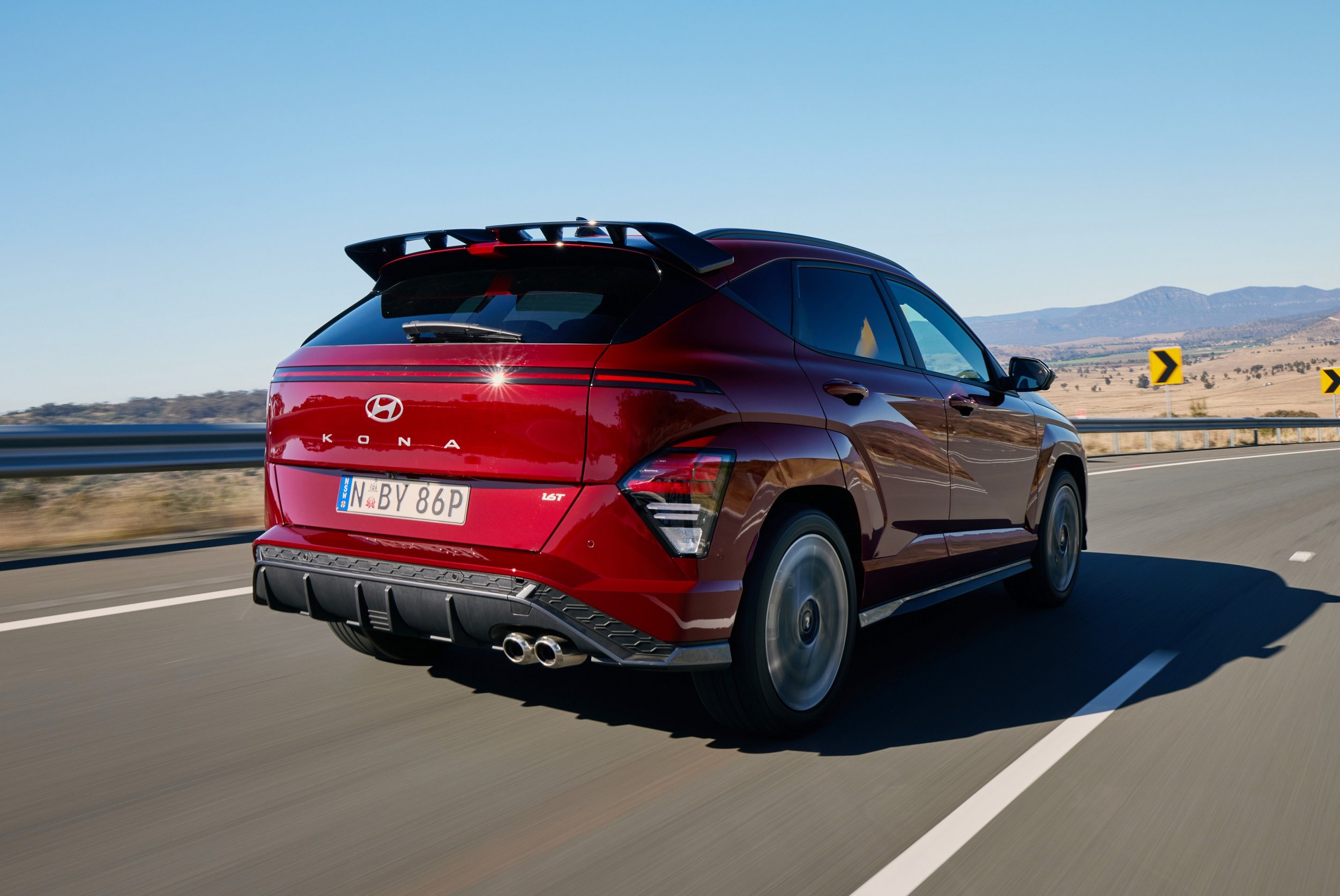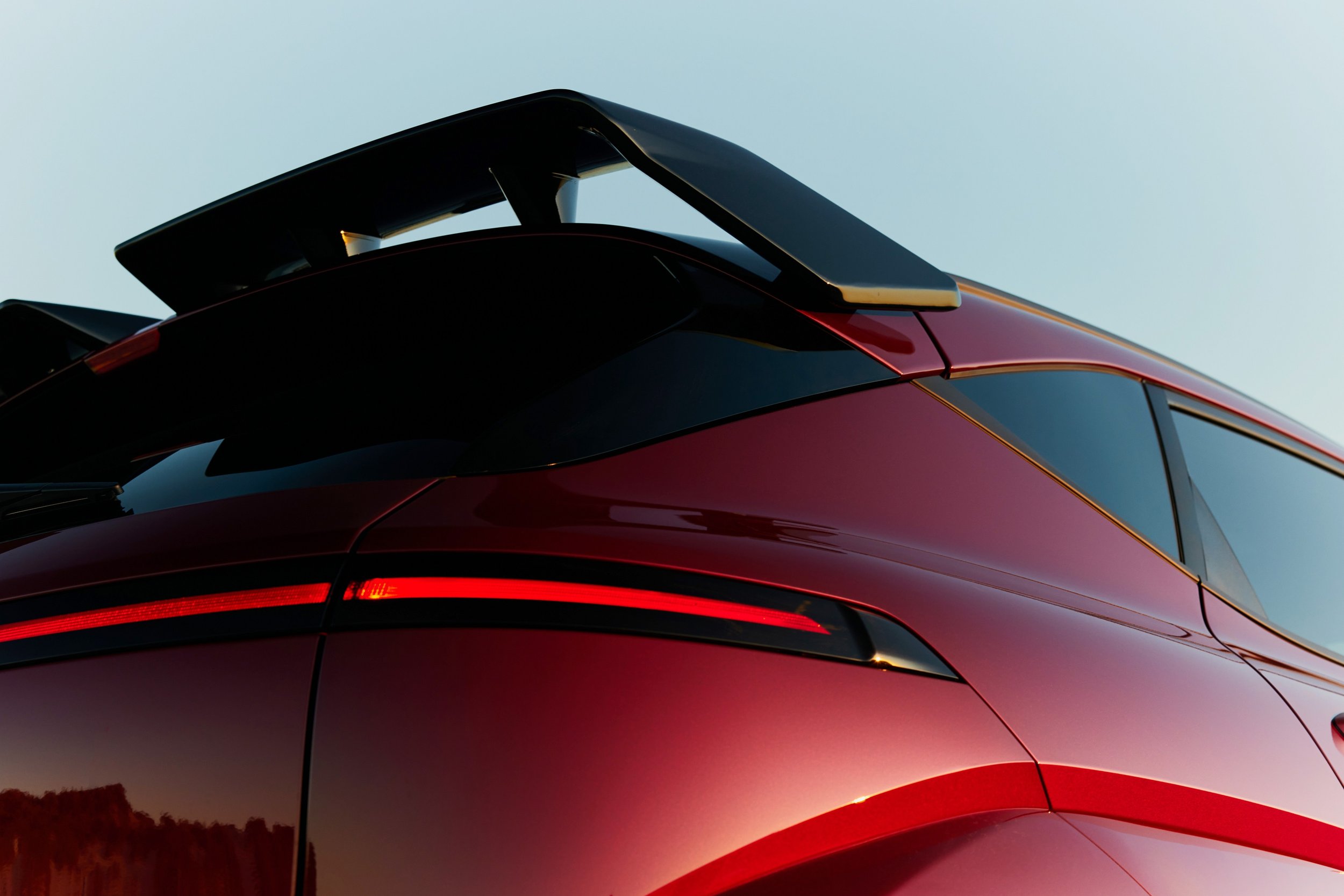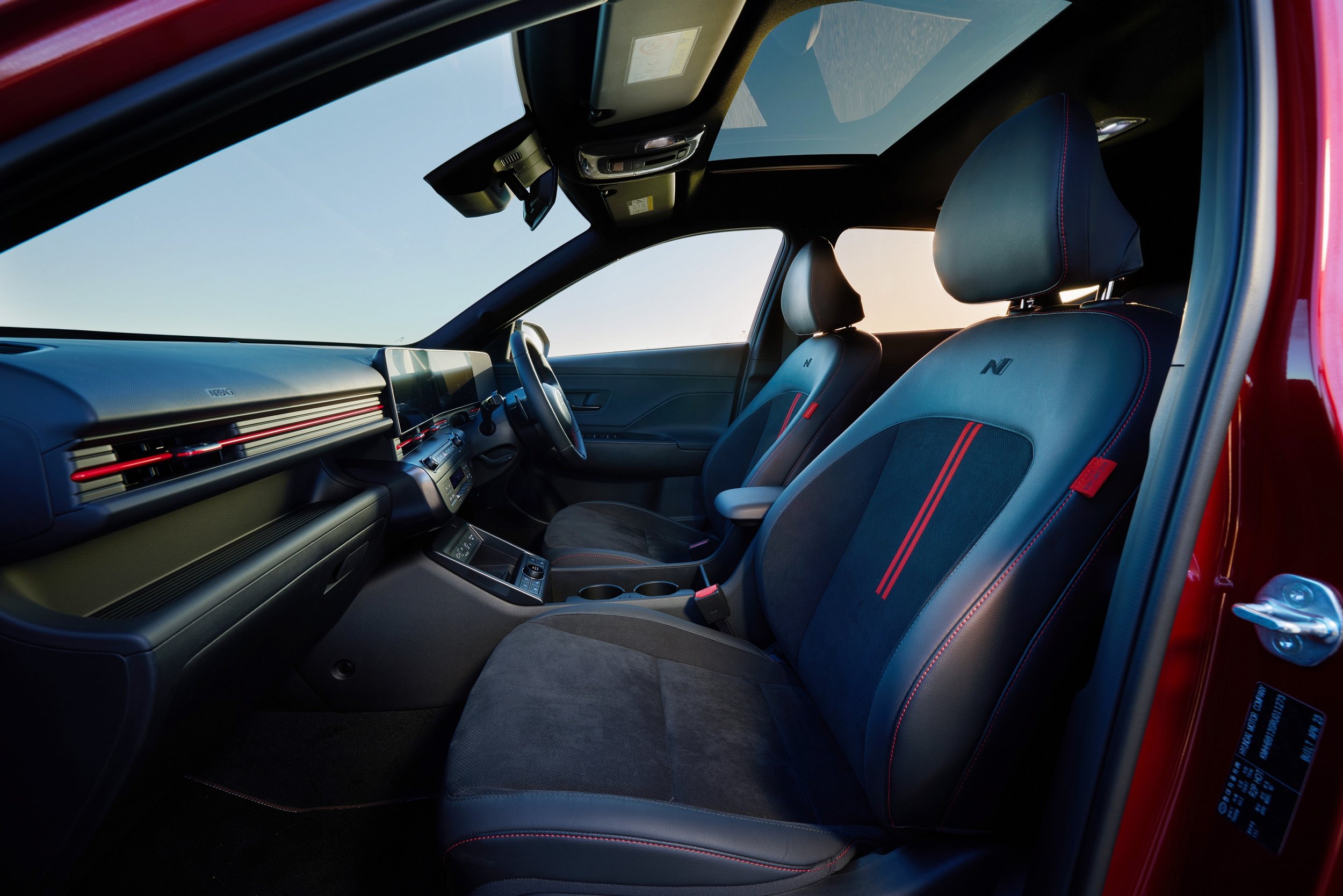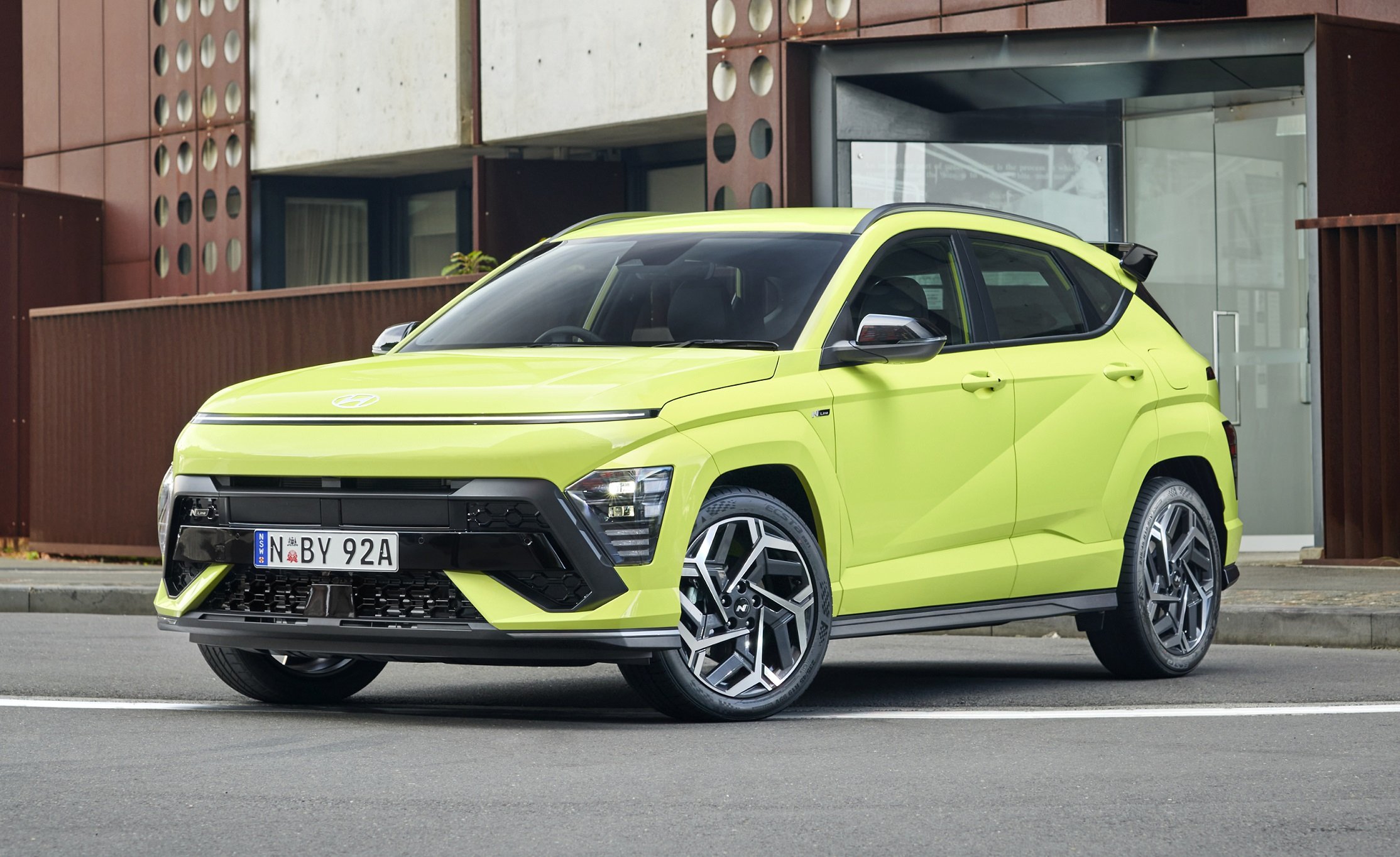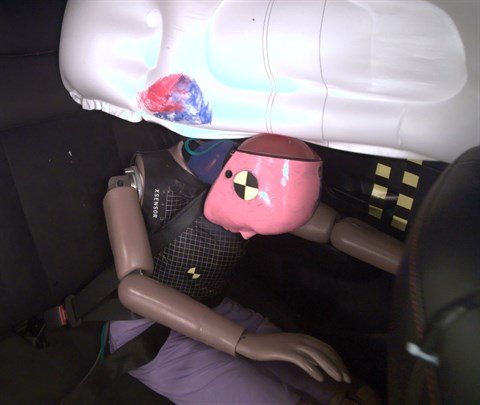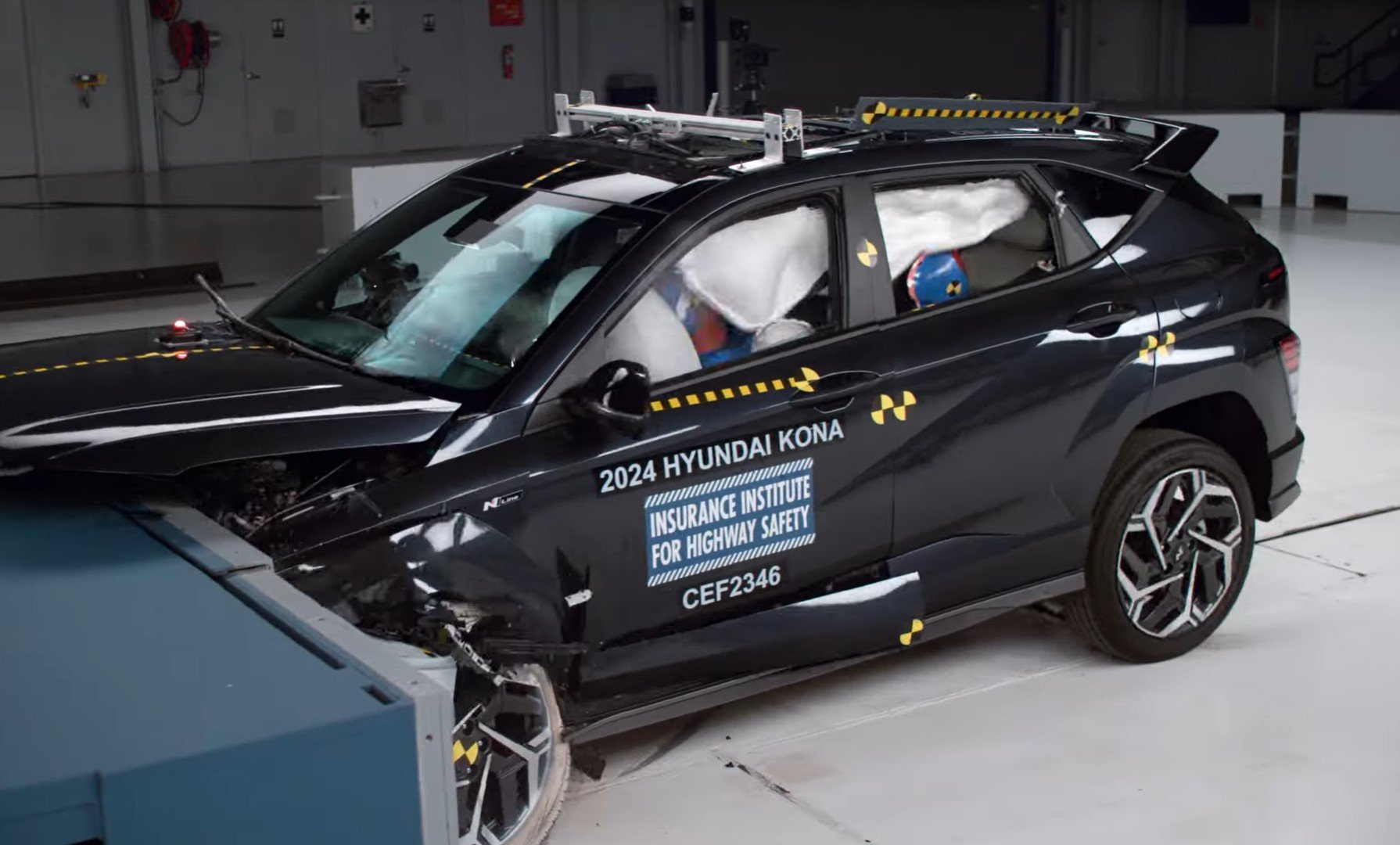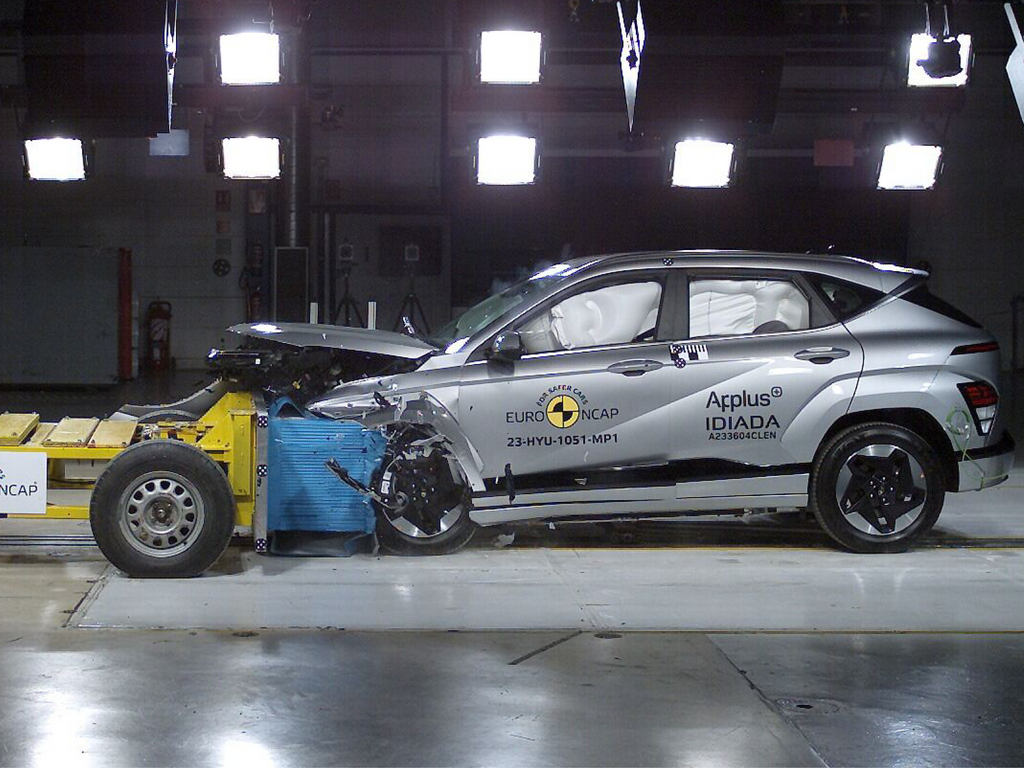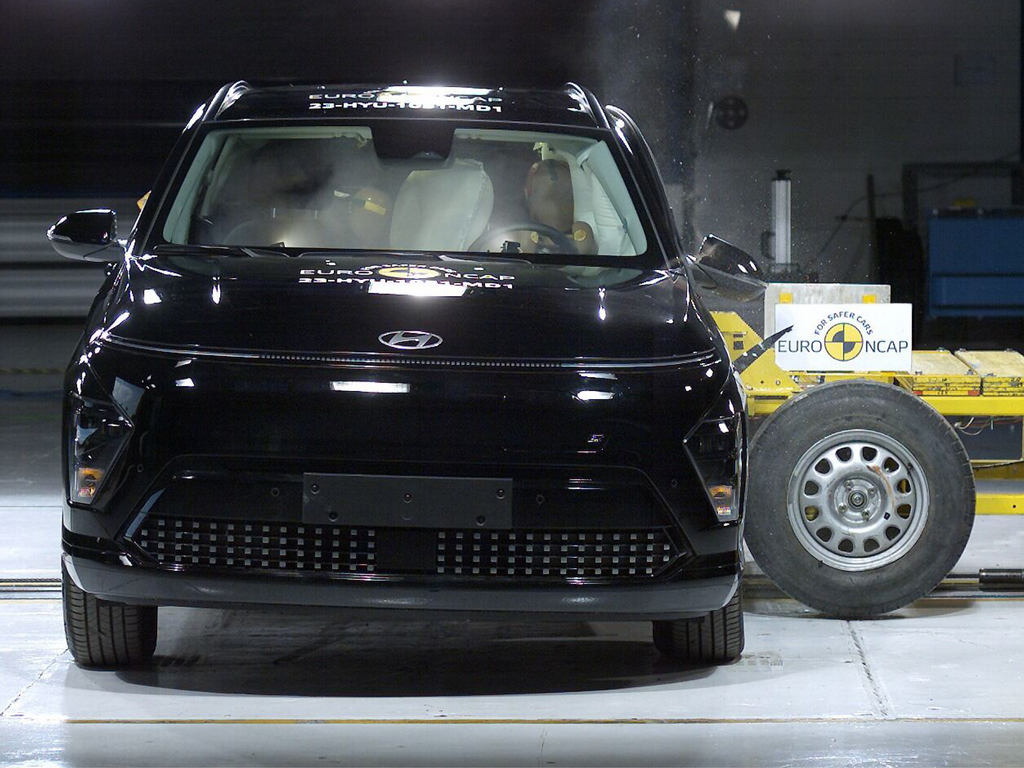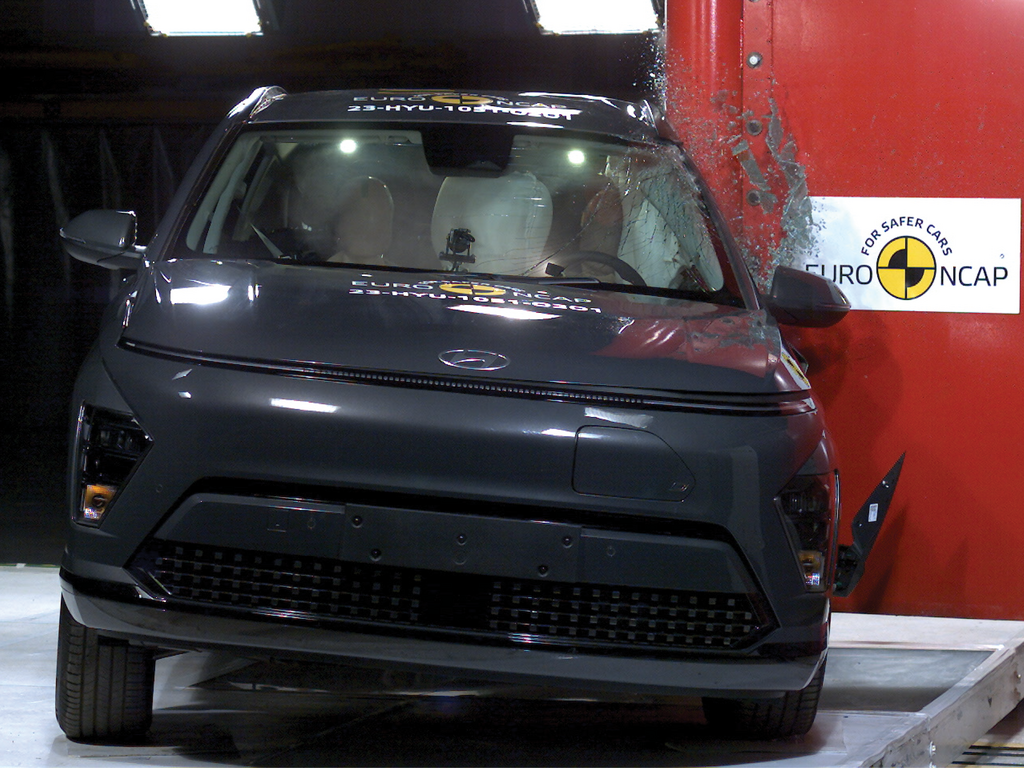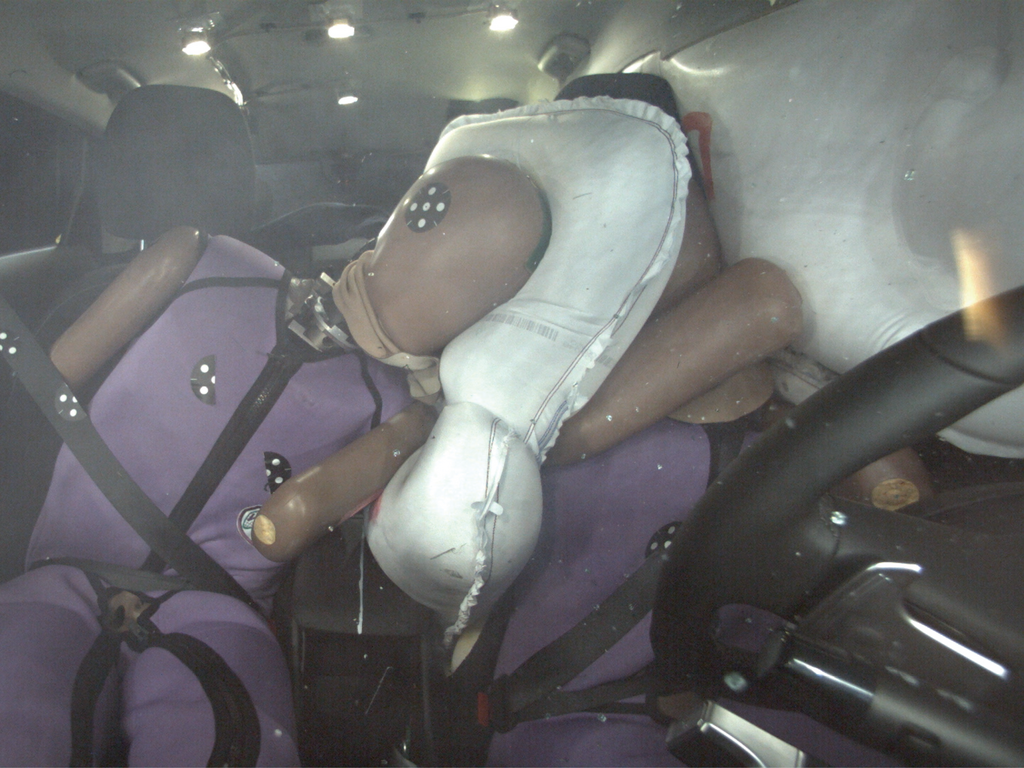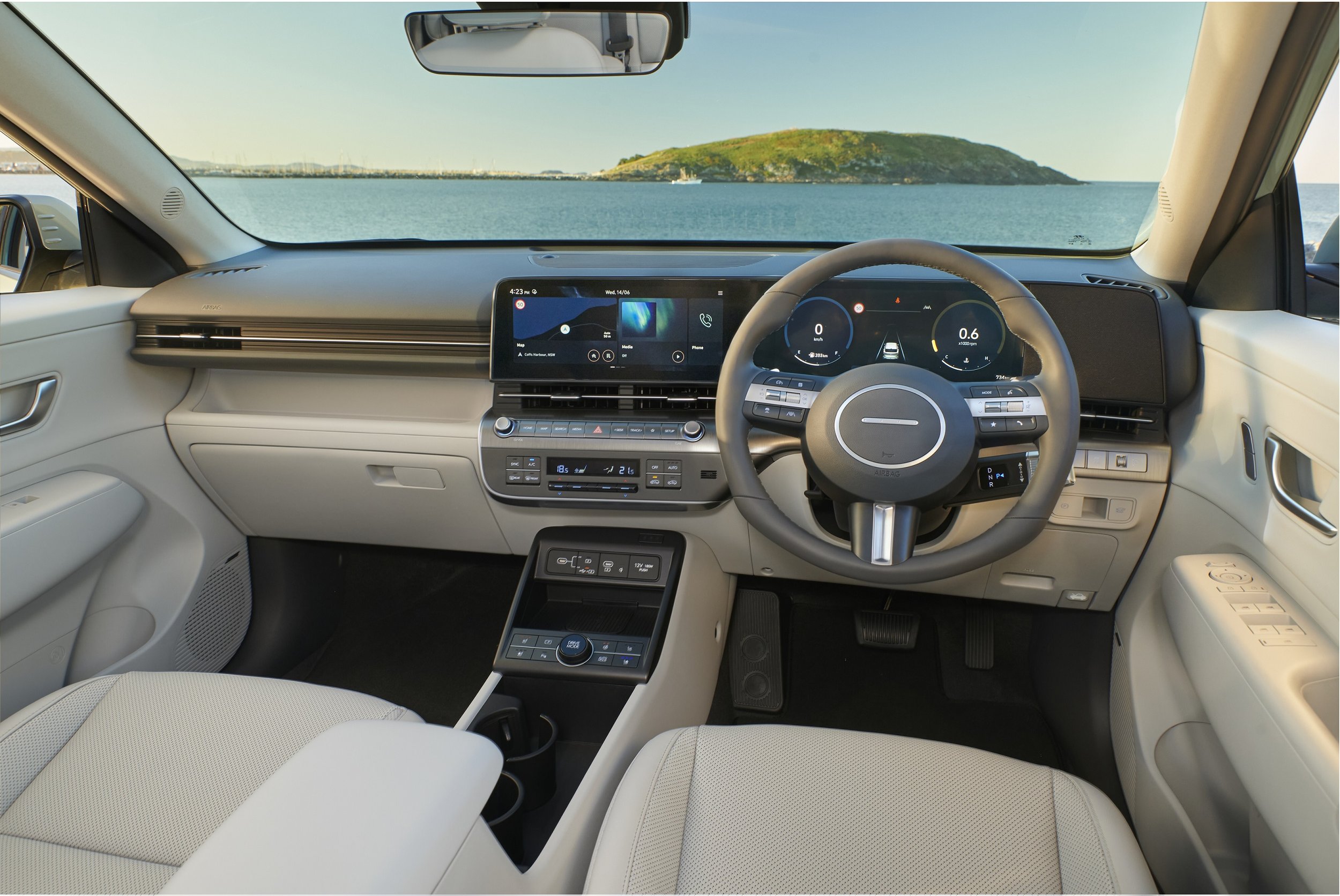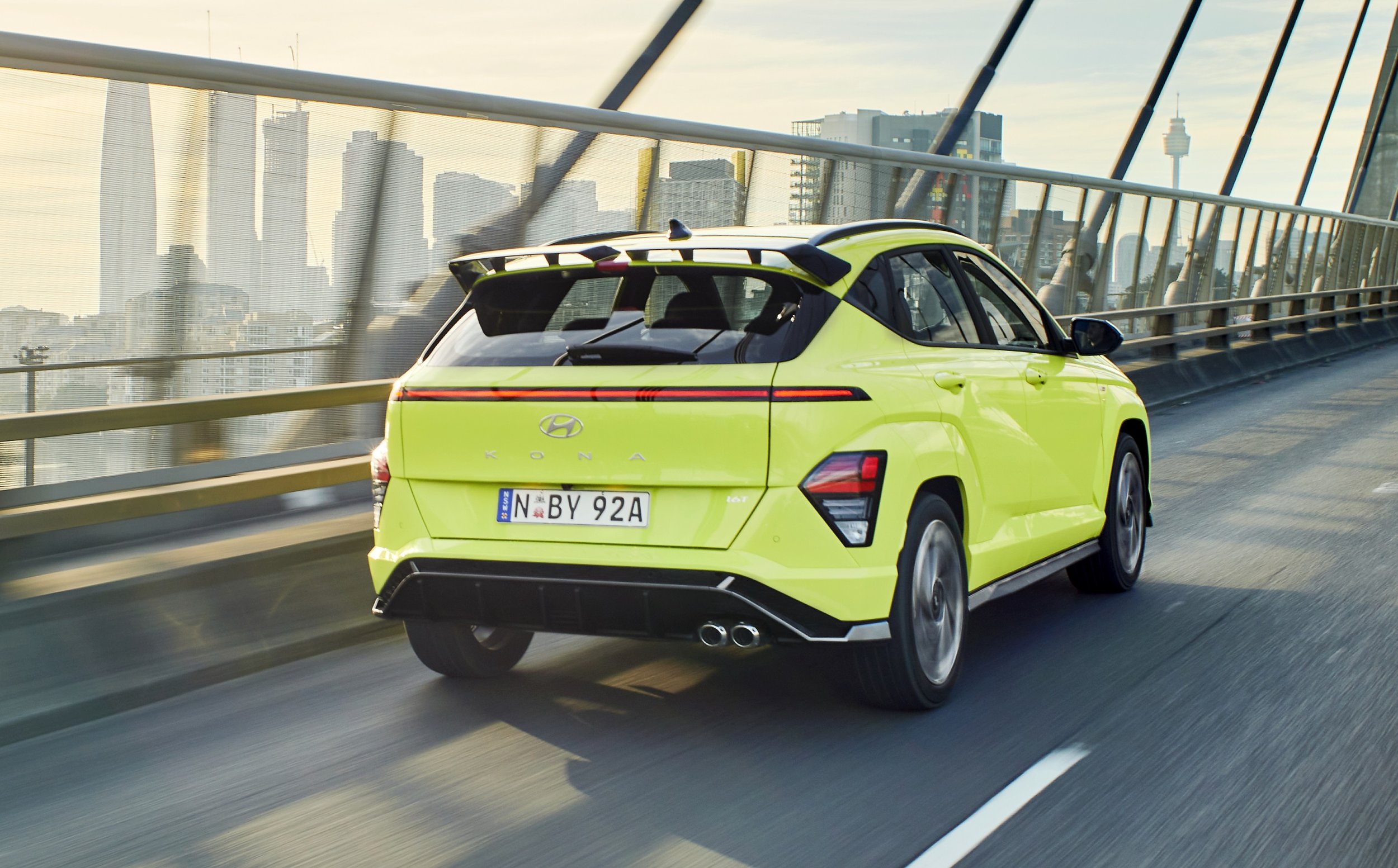Hyundai Kona review and buyer's guide
The futuristically styled Kona offers choice of engines, good safety and makes a strong case for small families needing options, reliability and quality at the right price. There’s even an electric or hybrid to consider.
The Hyundai Kona is one of the best-selling small SUVs on the market, but with this latest model, size has increased as well as the pricing. So we need to figure out if it has lost some of its value.
Kona now has the benefit of pedigree as the benchmark performance small SUV thanks to the N-Line package and the punchy 1.6 turbo and sporty dual-clutch transmission available on every model grade. So is it still worth your consideration, or has Kona just gotten fatter with age?
And does it still represent a value-for-money proposition for small families? Let’s find out. (If you want all the granular detail, download the Kona spec sheet here >>)
If you’re not interested in clipping apexes and power-to-weight ratios, then you’ll want to ignore the zany rear spoiler and body kit in these pictures and clap your eyes on the rest of the new Kona range.
Forget the multi-tiered model range of old. Kona now has two variants, either of which can be kitted with the N-Line pack.
This is a welcome change from the more complicated model line-ups you might find with ageing contenders like Toyota CH-R, Mazda CX-3, and Mitsubishi ASX. There’s also the strong-value Kia Seltos which is still pretty straight-forward and modern by comparison with those Japanese brands.
Also, the Subaru Crosstrek is a good choice if you need compactness but also a higher ground clearance with baked-in full-time all-wheel drive system, which might be worth a look as well if you want a soft-road capable camping and casual adventure machine.
New Kona is not just a stealthy, pumped-up design that you need to pay attention to here. More importantly, you need to think about choosing the powertrain.
See, while Hyundai has refined the styling to make it a bit more in line with the sleeker, Robocop-type look first borne on the Staria people mover, we need to discuss which version you’re going to consider because the choice couldn’t be any simpler.
Forget the multi-layered model range you’ve known in the past. It’s so dead simple now, even a B-grade politician could figure this out. It’s Kona base model, the Elite and Kona Premium. That’s it.
The base model Kona and Kona Premium get one powertrain, the 2.0-litre ‘Atkinson’ cycle petrol with CVT (FWD). But if you option the N-Line Pack, you can have either the 2-litre economy engine or the performance-focused 1.6-litre turbo-petrol with 8-speed epicyclic automatic (AWD).
So to clarify, this combination of 1.6 turbo, the 8-speed DCT and all-wheel-drive is available on either base Kona or Kona Premium, but only if you get the N-Line pack. This means you can’t have the primo 146kW powertrain without the body kit. Unfortunately, it also means you can’t have the hot engine in the lightest possible version; it’s only paired with the body kit which adds weight.
You need to decide if you want a hybrid, full-electric or conventional combustion-engine Kona, because it comes in all three flavours of powertrain and with a wide range of pricing as a result.
If you’re on a tight budget, you’ll want to be sticking to the entry-level hybrid or the lower-to-middle spec combustion Kona. If you’ve got a much more flexible budget, the electric Kona is a proper little stealth rocket, but if flare is more your style, the N-Line Kona is a firecracker.
If you need a specific review on the Hyundai Kona Hybrid click here>> You might be pleased to know there’s a realistic expectation you’ll make significant fuel savings.
FEATURES & PRICING
All combustion Kona model grades ride on 18-inch alloys with a space-saver spare. You get LED headlights and taillights on all variants, making that distinguishing feature no longer that when it comes to deciding between base or top-spec as is usually the case - pov pack gets the old halogen yellow-beams, top-shelf model usually gets the whizz-bang headlights. In fact, the N-Line even gets LED matrix headlights.
Dual-zone climate control. Premium variants come with the added appeal of a BOSE 8-speaker premium audio and power tailgate. And there’s a list of tech-rlated features which may or may not excite you. Things like valet mode, over-the-air software updates, Hyundai’s proprietary ‘BlueLink’ user experience. You can delve into more on that on their website.
Cabin refinement has improved with the use of a sound-insulating acoustic windscreen. Ride quality, tyre roar and general cabin intrusion has been treated by redesigning rear suspension mounting bushes. It’s hardly a Rolls-Royce Spectre with inches-thick applications of sound deadening material, but it’s a welcome upgrade from the slightly tinny, droning sound boxing your ears in on coarse chip road surfaces and potholes.
Pricing goes like this:
Kona base model | $35,500 approx. driveaway
gets:
DRIVING
Collision avoidance, blind-spot collision avoidance, lane centering and keeping, rear occupant alert and driver attention warning, rear cross traffic collision avoidance
360-degree reversing camera with dynamic guidelines
LED headlights (auto dusk-sensing), indicators, daytime running lights and taillights (still halogen rear indicators), LED interior lighting
4 x front & rear parking sensors
Adaptive cruise control
INTERIOR
Safe exit warning (opening rear doors to traffic approaching from the behind)
Front-centre airbag
Tyre pressure monitoring - so there’s no excuse for not having your tyres properly inflated
Wireless smartphone charging
Wireless Android Auto/Apply CarPlay
12.3-inch infotainment touchscreen, 4.2-inch driver’s display screen
Push-button start with proxy smart key and remote start
Dual-zone climate control, row 2 vents
Extendable front sunvisors
Manual front seat adjustment (incl. lumbar)
EXTERIOR
Heated auto-folding door mirrors
17-inch alloys
KONA ELITE | $40,000 approx. driveaway
INTERIOR
Leather appointed interior
Heated, power-adjusted front seats
Open type centre console
10-way (including lumbar) power adjustable driver’s seat
8-way power adjustable passenger seat
EXTERIOR
18-inch alloy wheels
Privacy rear glass
Solar control w/ screen + front door glass
Silver painted skid plates
DRIVING
Paddleshifters
Shift By Wire (SBW) w/paddle shifters (2.0 MPi)
Electrochromic mirror
Rain sensing wipers
KONA PREMIUM | $44,270 approx. driveaway
adds:
DRIVING
360-degree camera suite (incl. selectable front, rear, or side views, bird’s eye view w/tailgate guide lines, trailer connection mode, car wash mode, and front/rear ultra-wide view)
Reverse collision avoidance
Blindspot view monitoring
Drive modes- 3 settings (‘normal’, ‘eco’, ‘sport’)
Remote smart parking (forward and reverse keyfob operated)
INTERIOR
Leather seats, steering wheel and gear-shifter
Heated seats, front-seat position memory, auto driver’s seat entry adjustment
Auto-dimming rearview mirror
6 x front & rear parking sensors w/ detailed graphic display
Bose 8-speaker premium sound system, DAB+ digital radio
Satnav (w/ live traffic updates)
Voice command, weather forecast updates
Power sunshade, cloth knit headlining
EXTERIOR
Rear privacy glass, acoustically windscreen treatment
Wide glass sunroof
Auto rain-sensing wipers
Electric tailgate
KONA N-LINE | pack added to:
BASE | $41,150 approx. driveaway
ELITE | TBC
PREMIUM | $47,400 approx. driveaway
you get:
Leather & Alcantara seat trimming
Multi-terrain Mode - 3 settings (Snow, Mud, Sand)
LED front Robocop light strip and indicators
Single-side twin-tip exhaust
Multi-link suspension (rear) (Macpherson strut front)
Bigger front brakes
19-inch ‘N-Line’ alloys
‘N-Line’ interior and alloy sports pedals
‘N-Line’ rear diffuser, spoiler and bumper design
‘N-Line front bumper and grille design
‘N-Line’ door sill skid plates, side skirts
Body-coloured exterior wheelarch trim
Manual seat adjustment
You will have to have a firm idea of what features you specifically want with an asterisk over the items you can live without in the event it’s not present on the spec-level you budget for.
New Kona gets standard on all models what was the premium brake package in the old model’s upgraded N-Line variant, which are 305mm x 25mm discs.
If vibrant colours are your thing, the Kona still offers a bunch of fun colours like ‘Neoteric Yellow’, ‘Soultronic Orange’, ‘Ultimate Red’, ‘Mirage Green’ and ‘Denim Blue’. Why? Because not everybody wants corporate greys. But, the yellow, orange and the ‘Cyber Grey’ are exclusive to the N-Line pack.
If you don’t drive like a peanut, either powertrain is going to be well-suited to your driving, overall. And I did prove how tough the Hyundai dual-clutch transmission really is >> by subjecting it to the driveway from automotive hell. You’ll find more detail on DCT versus CVT below.
Kona Hybrid with the front-drive atmo 1.6 makes 104kW and the seven-speed dual-clutch transmission (found in the old model) is now a six-speed DCT. The hybrid in Premium spec (disregarding N-Line pack) has a power-to-weight ratio of 77 kilowatts per tonne, so it’s going to be quicker off the line than the 2.0L CVT with only 68kW/t, weighing 70kg more.
Check out the Kona Hybrid review and buyer’s guide here >> for more.
All Kona combustion powertrains will take 47 litres of 91 RON standard unleaded (or E10 if you’re into that), except for the hybrid which only has a 38-litre tank. Economy on the combined cycle, based on WLTP lab testing, is rated 7.6L/100km for the 1.6 turbo, 6.6L/100km on the 2.0 CVT, and 3.6L/100km on the hybrid 1.6 non-turbo.
If your driving is predominantly in the city, you’re going to save fuel in stop-start traffic when the battery is being used to get going from stationary. But if you spend a lot of time on freeways and country roads, the hybrid won’t be utilising its battery and motor, so you won’t be getting that fuel economy benefit.
DRIVING
With the 2024 model switching to the newer K3 platform, like what underpins the i30 Sedan (as opposed to the K2 featured under the old Kona and current i30 hatch), handling and refinement are undoubtedly improved.
There is a hybrid model coming later this year and a fully electric version, but for now Aussies can opt for a conventional 2.0-litre petrol or a 1.6-litre turbo-petrol four-cylinder. With the 2.0L you get front-wheel drive, a CVT gearbox, and torsion beam rear suspension.
A switch to a CVT auto in the 2.0L from the initial six-speed auto in the first Kona is going to frustrate driving fans, as the CVT doesn’t provide much engagement. But, the CVT is smooth and it seems to suit the entry-level character of the motor.
With the 1.6 turbo you get a new eight-speed torque converter auto compared with the old dual-clutch unit. This new setup is miles in front of the dual-clutch. Dual-clutch units definitely have their place in the world of sports cars, but for a practical run-around like the Kona, simplicity is the key.
The new transmission is very well behaved, shifting gears smoothly and in good time. Taking off from a steep hill is much easier, whereas before you had to hold your right foot on the brake.
This feels like a more wholesome machine, with excellent bump absorption on rough Aussie roads. And that’s on both the torsion-beam setup and multi-link. A revised beam tune has been applied to the 2.0L models, and for the most part, the difference between it and the multi-link is minimal, particularly during regular driving.
Ride comfort is tuned more towards softness than sportiness in my opinion, as there is some minor body roll coming into corners. But its ability to manage impacts from sharp bits of ground mean comfort remains a higher priority than outright cornering g-force.
Going for the N Line pack does nothing in terms of altering the driving dynamics. It uses the same fundamental platform and the same suspension tune as the non N Line models. In that sense it is disappointing that Hyundai has not provided more distinction for the N Line.
There are more on-board safety systems than ever before. One of the all-new systems for Kona is driver-monitoring technology, which warns you if you yawn or sneeze while driving. The software tune seems to find a balance between sensitivity and purpose, so it’s not too annoying.
Facing the other way, the adaptive cruise control system is still cumbersome like before. It doesn’t seem to recognise that, sometimes, cars in front are moving faster than you are. For example, pulling out into the overtaking lane just as another car whizzes through will cause the adaptive cruise to hit the brakes
And then it takes a good second for it to notice the car in front is going faster than you. So then it applies lots of throttle to finally reach back up to your set speed, wasting fuel in the process. It’s not nearly bad enough to scrub it from your shortlist, but it is a nuance you might notice in your test drive.
AUSTRALIAN SUSPENSION TUNING
Suspension is a surprisingly important aspect to buying a new car, particularly if you keep in mind it can be the difference between an SUV feeling ponderous and uninspiring or sporty and car-like. Driving a Kona - especially the 1.6 turbo - is the latter.
Hyundai Australia has a small team of magicians who develop a bespoke suspension and steering tune for our uniquely crap Australian roads. They are proving very talented at this.
I always get questions about exactly what does “unique tune for Australian roads” actually mean.
Well, basically it boils down to two things: Australian buyers are uniquely demanding when it comes to dynamic performance. In some other markets, it’s all about the styling and the features, and if the car just gets you from A to B, that’s good enough. Not so, in Australia. And the other thing is, of course, that Australian roads are crap. We’ve got a comparatively small population, big geographic area, and that means (per capita) we don’t have very much to spend per kilometre of road, and that’s why our roads tend to be (let’s be kind) not as good as they are in the US or Europe.
The engineers get something like four weeks to turn our dynamics frowns upside-down, juggling a billion permutations of dampers, springs and bushes, and then inscrutably arm-wrestling the factory over what they want and what the factory says they can have.
So the final dynamics tune is firm and sporty - if you know what you’re doing, Kona does exactly what you tell it to.
The reason this new Kona model is so distinctly improved is because in the hybrid and full-electric versions yet to come, they are engineered from the beginning on a platform designed to deal with those unique powertrains.
There’s a phenomenon called modal separation which occurs as a result of changing the mass-centre of the vehicle when you swap out the combustion powertrain for the heavy, low-down mass of the battery and more localised mass of the AC electric motors. These components are mounted in different places, but all the suspension geometry remains the same with the same pick-up points.
What this does is change how the vehicle behaves dynamically. So it bounces and rolls more profoundly because the suspension is not optimised for the change in how the powertrain mass is arranged. Combustion powertrains are more spread-out down the centre for the length of the vehicle front-to-rear. Whereas the battery and motors are kinda all in the middle, making for a very different set of engineering challenges.
This doesn’t happen in new Kona because the whole platform has been re-designed as an EV first, but to adapt for the combustion powertrain. So the 1.6 hybrid + DCT, the 2.0 CVT and the 1.6 8spd auto are all adapted to suit the EV Kona’s platform, not the other way around. This is a much better outcome for all powertrain types.
ENGINES
If you’re considering a Kona and wondering about the engine because you like that kind of stuff, you’ll probably want to know about the performance N-Line.
This means you’re most likely going to want to know about the 1.6 turbo-petrol engine with all-wheel drive.
The ‘N’ division has transformed the Hyundai brand into a heart-throbbing Euro-style performance option for enthusiast drivers with a modest or even just a rational budget. Just because you love cars and driving doesn’t mean you have to be extorted of the kids’ university savings.
If you want all the features you can possibly have on a Kona, the Premium with N-Line Pack is the one you want, but it does add 130kg over the normal Premium. Add N-Line to a poverty-pack Kona Kona and you’ll be adding . Sure, you get an additional 26kW of peak power (146kW at 6000 RPM) from the 1.6 turbocharged petrol engine (which runs on 91 RON fuel by the way), but adding 200-plug kilograms is not insignificant.
If outright performance is your modus operandi here, firstly, you’re shopping for the wrong car (get the balls-out i30 N or Fastback N), and secondly, if you want the fastest Kona, you’ll wanna concede on things like the sunroof in the N-Line Premium and go for the more stripped back N-Line. It’ll save you a $6000 too. N-Line Premium weighs 1504kg (kerb) and the down-spec N-Line weighs, without the addition of a sunroof, electric seats with heating and ventilation/cooling, the big dashboard cluster screen, heads-up display etc., is 1395kg - that’s a 109kg weight saving.
I guess you could look at it like this: You can get more (performance) for less, or more (equipment) for a fraction more.
The good news is your N-Line will look pretty much the same as the Premium, save for the glass roof and slightly yellow headlights.
Either way, the swansong of N-Line is, of course, that crackling 1.6 turbo and dual-clutch transmission - a perfect pairing, like Vegemite on buttered toast, or Ming Molls in the hot tub.
Compared with a range-topping Mazda CX-30 G25 Astina, the Kona N-Line Premium’s principal competition for your money (and so it should be), the Hyundai has 7 more kilowatts of peak power, and the Mazda gets a torsion beam rear end, front-wheel drive only and it has smaller brakes. But the CX-30 is slightly lighter at 1478kg (kerb) versus the N-Line Premium an extra 26kg heftier; however the Mazda’s power-to-weight ratio is still 86.6kW/t versus 99.1 for the Hyundai.
The CX-30’s six-speed epicyclic automatic transmission will be slightly more refined in routine stop-start city traffic, but the Hyundai DCT is so well designed you probably won’t notice its indiscretions in-traffic.
Then, inevitably, we come to the Kona’s biggest quirk: styling. Undoubtedly, the CX-30 is better looking but it’s also a bit aesthetically boring, and I’d argue the Mazda’s interior earns many comfort points above the Hyundai. But some people love the funky sharp lines Hyundai is coming out with lately. It’s certainly a more bold approach than Toyota’s lame-duck attempts to be interesting.
But the Kona N-Line Premium will be quicker than its competition, so there’s that.
I'll help you save thousands on a new Hyundai Kona here
Just fill in this form.
No more car dealership rip-offs.
Greater transparency.
Less stress.
TRANSMISSION
Hyundai mates its Continuously Variable Transmission to the 2.0-litre naturally aspirated petrol engine which is found in Seltos, i30, and Cerato. Although, the CVT is found in Seltos and Kona, but not in Cerato and i30.
The dual-clutch is very good in this vehicle, clearly the product of good R&D. But you must be weary of excessive wear on the clutch caused by creeping and inching forward in traffic.
I did a torture test on Hyundai’s dual-clutch in the Hyundai Santa Fe which should attest to how robust it is and the quality R&D done on it. (Same goes for Kia products as well because: twins under the skin.)
However, the CVT has had, let’s call them, idiosyncrasies. The most irritating of which is the delay (measurable by a calendar, in engineering terms) between putting your foot down - as you try to pull out of an intersection quickly - and when the gearbox finally chooses the right ratio through which to transfer power to the front wheels.
If you’re just driving normally, at regular speeds in average suburbia, it’s fine, mostly. But there are moments where this powertrain can be frustratingly dim-witted and unintuitive. If you’re in heavy, built-up freeway traffic at 5pm every day, with constantly changing speeds and idiots frequently swapping lanes to no avail, you’ll want to simply hang back as far as possible and keep your speed as consistent as possible.
It’s not a bad transmission, per se, you just have to adapt to it (like all aspects of new-car ownership), and the learning curve for some might be steeper than for others.
It’s fair to say Hyundai/Kia’s CVTs have needed some refinement, which has been noticeably improved. Is it as good as Subaru’s new generation CVT in Outback, WRX and Crosstrek? In the throws of real-world driving, Subaru should be concerned at how quickly they’ve been caught up to.
However, if you’re not interested in the pure performance aspect of the Kona N-Line variants, the Premium with CVT and 2.0-litre petrol will be quite okay for the vast majority of normal driving you’re likely to do. It just requires a little bit of software updating upstairs to learn how to get the CVT to do what you need it to do.
In those tricky intersections, for example, you might want to practice left-foot braking in order to hold the brake on with your left foot while gently touching the throttle with your right foot as you prepare to do a mini launch when the traffic becomes clear. This would be a good skill to have on dodgy corners and blind driveways where you can’t always see the approaching traffic.
Also, practice looking further up the road to better anticipate what traffic conditions are approaching, so you can be prepared earlier and drive accordingly.
The DCT versus CVT debate rages on with the Kona and Seltos lineups, but ultimately they’re both going to drive quite okay in most situations.
CVTs are generally good for routine city driving in metro areas, and the DCT for more at-home in spirited, cross-country roadtrips or general country road use where the driving requirements are predictable.
But they’re both going to be fine to cross over into their other’s area of preferential operation. But you should understand the pros and cons of each.
For example, Hyundai’s DCT built by Hyundai has plenty of R&D development baked into it, so daily commuting is going to be a piece of cake, and likewise, the CVT will still work nicely on the open road and for overtaking on the highway.
But you need to be aware of the potential for increased wear and tear if you mis-use each transmission.
The CVT is prone to unpredictability if it’s driven like a regular epicyclic auto. You can prematurely wear out the drive pulley if you thrash it with big throttle inputs. You want to be smooth and progressive.
Likewise, the dual-clutch transmission is brilliant for lightning quick gearchanges in sporty, predictable driving where it knows what gear it needs next. But if you have that bad habit of creeping forward in traffic that is at a standstill, you’re going to torture the clutch and wear it out early - and no, this is not a fault of the Hyundai DCT, it’s the nature of all DCTs, generally.
FUNCTIONALITY
Kona is now 3cm taller and 14.5cm longer than the old Kona, and has 6cm of additional length in the wheelbase. This means more legroom, more headroom, and greater rake angle on the seatback for longer journeys - typically the lesser known drawback of small SUVs.
The true Achilles heel however, is luggage space. Small SUVs have hateful levels of space to put your stuff, which is why they catch you out at airport rental car services when you go to load your suitcases only to find someone’s getting their American Tourister on their lap.
Check the figures if you have big stuff to take routinely; we’ll get into the details on Kona V Tucson below.
New Kona has more luggage capacity thanks to a longer body and in spite of a slightly reduced rear track (which would bring the wheelarches closer together). The luggage volume increases by 33 litres to 407 and expands to 1241L when you drop the back seats to an “almost-flat” 10 degrees. The bigger body dimensions naturally translates into 85 litres of additional total maximum luggage space over old Kona, when you drop row 2.
Hyundai has also increased the boot aperture by 3.8cm and lowered the boot floor to what they call a “loading height” of 676mm. Now initially that seams great, and it is a distinct advantage for getting heavy stuff in. The question thereafter is, ‘Is it now harder to get heavy stuff out?’ A difference of 6.7cm should affect many who are probably fit enough, but elderly people might prefer an elevated boot floor.
(Click to enlarge:)
The latest Hyundai Kona is significantly bigger than its predecessor. It’s bigger than the current i30 hatch, which has been around for a long time. It won’t be long before the small hatch is superseded.
When current i30 and latest Kona invade each other’s personal space, it becomes quickly apparent the i30 (4345mm, N-Line) is still actually longer by 5mm (Kona: 4350mm). The i30 no longer wins on cargo capacity, either, because with the rear seats upright - i30: 395 litres; Kona: 407 litres. But with row 2 down it’s the same story as before with old Kona. The i30 takes 1301 litres; Kona: 1241 litres.
The same can’t be said for wheelbase, which translates into passenger compartment legroom; it’s now better in the Kona: 2660mm; i30: 2650mm. Yes, we’re splitting straws over millimetres here, but these are still the facts.
What you need to figure out is whether the several grand extra for Kona is worth those benefits over a minutely smaller i30 which only has 35mm of additional ground clearance. That’s 3.5cm!
But there’s more to this size problem you need to digest before choosing where to put your money.
The extra height in Kona makes a real difference in the back, especially if you have to load kids in and out. There’s 132mm more height in the cabin compared with an i30, so rear seat passengers sit up higher, and they’re less likely to clunk their heads on the way in. There’s better forward vision for them, as well as more wriggle room for the toes under the front seats. Growing family owners, take note.
But the growth of Kona puts it very close to the more expensive mid-size Tucson in terms of wheelbase (passenger legroom), length and luggage space. Tucson also represents a potential $7000 premium over Kona. But you have to ask if there is a seven grand advantage in Tucson anymore.
Tucson is 4630mm long, Kona is 4350mm - a difference of 280mm (just 2.8cm) - or a mere 6 per cent more with Tucson.
Tucson is 1865mm wide versus Kona at 1825mm, making it 40mm (4cm) narrower in Kona which you can loosely translate into shoulder room.
Height is 1665mm on Tucson versus 1585mm on Kona, meaning just 5 per cent more potential headroom in the Tucson. That’s a 120mm difference, or just 12cm.
And the wheelbase of 2755mm on Tucson (which is the same as Kia Sportage, by the way), is just 3 per cent longer than the 2660mm on Kona. Essentially, it gives you 95mm (9.5cm) of additional potential legroom.
So how do you intend to use the hypothetical Kona you might purchase here? Is this going to be a family taxi taking multiple kids to school, school holidays away on trips around the place, sports on the weekend, long regional drives and so on?
Or is this a second-car type purchase where you might drop the kids off, hit the shops, run around town and/or commute to and from the city multiple days or every day of the week - and is there a bigger vehicle already in the driveway for weekends away, perhaps camping trips, family events and so on?
Do you need to max out this vehicle week after week with plenty of luggage space, a full-size spare in rural areas and ample legroom for especially tall teenagers and burly dads? Or is this a vehicle for strict suburban driving in carparks, city streets and rare expeditions beyond your metro area?
And does Tucson sound like you need the $4000-$7000 worth of extra vehicle? If you have long cricket or hockey bags to take to training and games three times a week with six-foot teens, then Tucson represents an advantage. But so too does a seven-seat Hyundai Santa Fe >> from $50,000-76,000, with a much bigger boot, the option of a third row for self-invited high school guests, and a diesel powertrain with AWD for those bigger weekends away that also require light towing capability.
SAFETY
In 2024 the Insurance Institute for Highway Safety (IIHS) has Kona rated as a ‘Top Safety Pick+” which is about the highest honour they could bestow on it. But at ANCAP, they seem to think Kona is some kind of sub-standard safety botch with its 4-star rating. So which should you believe? Let’s decompile the tests so you can understand just how safe Kona is.
The IIHS in North America has determined the Kona is damn-near perfectly safe. It has ‘good’ scores across almost every criteria across al the major tests. There isn’t a single ‘poor’ or even ‘marginal’ score for Kona - the only minor mark-downs in tests are ‘acceptable’ - and even then it’s the headlight test and the child restraint attachments.
Even in the ‘driver assistance’ systems testing, the IIHS determined it was ‘good’ at overall pedestrian collision prevention - even at night, the hardest of all the ADAS tests to pass. Again, in the very severe small-overlap test (pictured below), this was as harshly as the IIHS got about Kona. In the crash:
the shoulder belt moved too far upward toward the dummy’s neck, compromising the effectiveness of the rear restraint system
The rating given for this performance was ‘acceptable’, and so too was the leg/foot injury. ‘Acceptable’. And even in the below neck loads measured, the IIHS still highlights that the:
Rear passenger dummy injury values indicate a low risk of injury to the head or neck and chest.
But ANCAP has other ideas.
the real disappointment… is the Hyundai Kona which scrapes by with four stars, in reality, lucky to to avoid three stars
- ANCAP
Can you guess why this so-called safety advocacy organisation rates Kona so lowly? It’s in the picture above, taken from the full ANCAP Kona rating report >>. Yeah, you guessed it: the driver assistance systems. So here’s what happened and why ANCAP is wrong. (You can also watch the video report above).
A four-star car dated 2024 versus a five-star car dated 2017, for example, well you should take today's four-star car, if you have to crash. Every time. Especially in the tests where the main deficiency lies in in all the annoying, badly implemented so-called ‘tech’ that ANCAP keeps piling on in its masturbatory five-star fantasy - and there's no evidence that any of it works.
There’s no ignoring the fact Kona was marked down for its performance in the full width crash test at 50km/h straight into a concrete wall. But this is a small car tolerating a crash where bigger vehicles like the Tucson, Santa Fe and Palisade all do a better job protecting the driver because: bigger vehicle.
The default categorization from ANCAP, by inference, is that anything less than five stars is a death trap here in Australia:
Last placed and the real disappointment in this release is the Hyundai Kona which scrapes by with four stars, in reality, lucky to avoid three stars
I mean if it's such a “disappointment” in Australia, how can exactly the same car be a Top Safety Pick+ in America? Why have six increments from zero to five stars when anything less than five is purportedly a deathtrap and therefore unacceptable?
This result is due to its substandard test performance, especially in driver assistance and crash avoidance.
ANCAP therefore offers a binary rating system misrepresenting itself as a 5-star rating system which is entirely unhelpful to consumers like you who just need to understand if it’s a safe vehicle - which it is.
In that full width test the Kona was pinged a bunch of points as you can see in this screenshot taken from the technical report:
But the context here is, the brown doesn’t mean certain death, and nor does the red pelvis graphic. What it means is much more work for the paramedics in the unlikely and highly tragic event of a crash into a concrete wall at 50km/h, with no intention of braking. It’s going to hurt, such a crash, but you will survive. You might be in brutal agony from the forces imposed on your body by the seatbelt, but Hyundai’s engineers have done just enough to make sure you live through such a crash.
What ANCAP has taken aim at the Kona for is its so-called ‘driver assistance’ and collision avoidance guff. Kona hit the cyclist in one of the tests, but got good scores for a bunch of the other cyclist and pedestrian related tests. There are many more tests than just the one you see in the video highlighting the impact with the simulated suicidal cyclist riding out in front of oncoming traffic doing 60km/h or thereabouts.
The fact EuroNCAP didn’t test the AEB ‘backover’ feature because it wasn’t available on the supplied vehicle, Hyundai Kona wasn’t given the opportunity to earn those points. This also happened for the AEB junction crossing feature where the vehicle is supposed to brake when crossing the path of an oncoming vehicle.
“Tests of the AEB Head-On functionality showed MARGINAL performance. The standard AEB system does not react when crossing the path of another vehicle. A system with AEB Crossing functionality is available on higher variants in Australia and standard in New Zealand, however this was not tested.”
So you can have that feature, as well as AEB backover, but you just have to pay for this feature which “was not standard on the tested vehicle and hence these tests were not conducted” according to EuroNCAP.
Nose-to-tail crashes are the ones that happen every day and never make the news; Kona performs here.
It’s also worth noting that in fact the AEB system performed very well in plenty of mundane driving tests where a vast majority of actual crashes happen on our roads - low and medium speeds in built-up areas.
So Kona isn’t some crude death trap like ANCAP might have you think. It’s very safe, and you should not be put off buying one because ANCAP doesn’t know how to make its rating system make sense for regular consumers, seemingly.
KEY COMPETITORS
Mazda CX-3
Mazda CX-3 has a 2.0-petrol, and Mazda is still in love with its third-rate MZD Connect system - and swimming against the tide of customer preference there, I’m sure.
CX-3 is an excellent SUV that I recommend routinely. It's quite polished, but not the same size as Kona because it’s based on a Mazda2.
The 2.0-litre engines from both manufacturers are similar (I'd give the slight edge to Mazda there). However, the 1.6 turbo Kona blows the CX-3 out of the water on performance criteria.
Mazda has kept updating CX-3, too, including adaptive cruise and a 360-degree surround-view monitor at the top of the range. Details here: Mazda CX-3 review >>
Subaru Crosstrek
Subaru Crosstrek offers the works burger - including adaptive cruise control, GPS, a very squared-away EyeSight safety system, and awesome Symmetrical AWD (competitors offer on-demand AWD) plus Apple and Android.
But the 2.0-litre engine/CVT transmission combination performance does not match the 1.6 turbo Kona. You would pick the Crosstrek because you’re frequently driving on shitty rural backroads where AWD is a necessity on gravel, in mud, loose dirt and soggy driveways. More here: Subaru Crosstrek review >>
Mitsubishi ASX
Mitsubishi ASX has a strong 2.2-litre version with all-wheel drive (and a mediocre 2.0-litre petrol). Mitsubishi offers a substantial 10 Year/200,000km warranty on the basis of servicing within the dealer network, unlike Hyundai’s and Mazda's 5yr/unlimited-kilometre warranty.
But ASX is one of the cheapest in the segment which, for any small family, young adult or elderly drivers who don’t need all the fancy design and elaborate technical options, it’s a compelling value option. More on Mitsubishi ASX here >>
Kia Seltos
Seltos is Hyundai Kona’s dyzigotic twin under the skin. It uses the same platform and powertrains, but offers a different design execution.
You don’t get a dedicated hot version like the N-Line, but a GT-Line Seltos with the 1.6 turbo-petrol and dual-clutch transmission will go like a cut cat.
The all-wheel drive system is a more active system unlike the one in Mazda’s arsenal, but Seltos’s still favours front-drive while diverting drive to the rear on a more responsive basis. It just doesn’t do full-time all-four drive like the Subaru. Full Kia Seltos review here >>
DON’T BUY these SMALL SUVs
Volkswagen T-Roc?
The problem with Volkswagen is they will probably throw you under the bust when it comes to exercising your consumer rights in the event of something failing on your T-Roc. It’ll drive beautifully and feel wonderful to sit in - there’s no denying the quality product, but the culture is terrible.
That’s not to say it will fail, either, but in the event you need support and a remedy, at the first opportunity, Volkswagen Australia and its dealers have a tendency to see what they can get away with, rather than doing the right thing by you.
Modern Volkswagens are becoming known for poor reliability as well. So there's that.
Nissan Qashqai
Nissan Qashqai is what you get when you almost try hard enough to do an adequate job. Six out of 10 … and that's being entirely generous. Nissan Australia’s commitment to customer care is also a farce, in my view.
The e-Power hybrid powertrain is a complete engineering botch and a cynical attempt to sell you on fake green credentials. Check out Why Nissan e-Power is a joke here >>
Move on, nothing to see here.
INTERIOR
The ergonomics are fantastic in Kona. It feels like such a tightly packaged vehicle, it feels wrapped around the driver, and in particular the steering wheel on the base model is hardly poverty.
Hyundai has made it clear that functional, haptic buttons are not going to be replaced by enormous touchscreens. This is good.
Big touchscreens, especially vertical tablet-style ones lull the driver into distraction. This pro-button design is excellent for overall levels of attention. You don’t need to take your eyes off the road trying to orient yourself, locate the (often) badly designed iconography and attempt to get your finger onto it without wandering out of your lane or glancing something with your shiny alloys. Hooray for common sense.
Overall, in terms of comfort, support from the seats, pedal positioning, visibility and driver centric clarity of information displayed, everything fits just Goldilocks. You intuitively know exactly what’s going on.
Control feedback is excellent - the steering feels natural whether you're driving sedately or pressing on, and it's hard to fault the vehicle in this area.
And then there’s the whole N-Line thing. Dynamically it opens the Kona up to a whole new range of interested buyers who are gunna be forced to get an SUV for their budding family, but don’t want to sign-up for the vasectomy special. They may also have one of those rare things (in the Millennial generation) known as a ‘budget’.
Anything with an N-Line badge goes like stink. You can comfortably squeeze the throttle and feel the turbo spool and push you the little bit harder toward the next corner, without trying to rip you off the road like some fanboy Golf GTI wannabe-racer.
The rear suspension in N-Line is a multi-link rear as opposed to the torsion bar rear in the Premium. So it’ll handle speed in the corners with greater competence and without wanting to ‘bounce’ or lift the inside rear. If you want the most dynamically superior Kona, get the N-Line.
But if your motto is more ‘steady as she goes’, stick to a Premium or base Kona without the N-Line pack.
.
DRAWBACKS
There’s no such thing as the perfect car or the perfect SUV - here’s a couple of things I really don’t like.
SPACE SAVER
A space saver spare tyre is standard - and unfortunately, a full-sized spare doesn’t fit. I know they were working on a full-sized option, but that’s been given the official thumbs-down by the boys upstairs. You could probably dodgy one up - but the removable cargo floor would need to be raised to a non-factory degree.
TOWING
Let’s be clear. Towing with a Kona, in any powertrain, is going to be a very limited affair. But at least it’s easy to understand.
Maximum braked towing capacity on all variants is 1300kg, with a maximum towball download limit of 130kg. It’s not great, but it’s no completely rubbish either. A light 6x4 trailer with the odd mattress, building supplies, maybe a bit of gravel or mulch for the garden should be fine. Even a bunch of camping gear will happily go in the trailer to leave room for the kids, if you’re inclined to take them.
No more manual
There’s no manual transmission anymore. No more self-shifting, rev-matching, tri-pedal dancing along your favourite twisty backroads. Happily, gone too is the stalling at lights, wondering if you left it in-gear on a hill and bad habits like resting your hand atop the gearstick to prematurely wear out the selector forks, down there.
Conclusion
I think the case for a base model Kona Kona is so compelling now thanks to the extensive list of standard features, it’s hard to see a need for the Premium.
Although some of the Premium’s features are kinda nice, you could probably put to better alternative use the $7800 extra it would cost for the Premium.
One of old Kona’s biggest flaws was its lane-keeping system which has been markedly improved on the new model. It no longer pinches the steering wheel from underneath your own inputs, instead gently easing you back toward the lane’s central region. The result is a much less unnerving feeling that you don’t have full control; less surprising to the driver.
Thankfully you can still turn this function off.
But there is a genuine question on the point of buying a Tucson now that Kona is so closely matched on overall size. There simply isn’t an objective winner between the two models, and the price is skewed against the Tucson. I think the right choice there is exclusively down to you, and the vagaries of your needs and wants. If you need the ultimate size, Tucson wins on paper, but in terms of value, Kona nails Tucson to the wall.
There’s no question Kona is a high quality compact SUV - and it’s a clear winner in this segment if you want performance over the other players in this section of the market. The 1.6 turbo remains distinctly separate from the other two powertrains - it just does so much with very little.
Hyundai provides excellent customer support, too - which is very reassuring because cars aren’t toasters. You just don’t whip down and replace one trivially, if there’s a problem.
If you’re uncertain about Kona, drive a Subaru Crosstrek and a Mazda CX-3 at the same price-point for comparison. Hit me up on the website if you’re in the market. We can get you a solid discount on anything - but in Australia only, tragically enough. I hope this review helps you decide what to buy.


